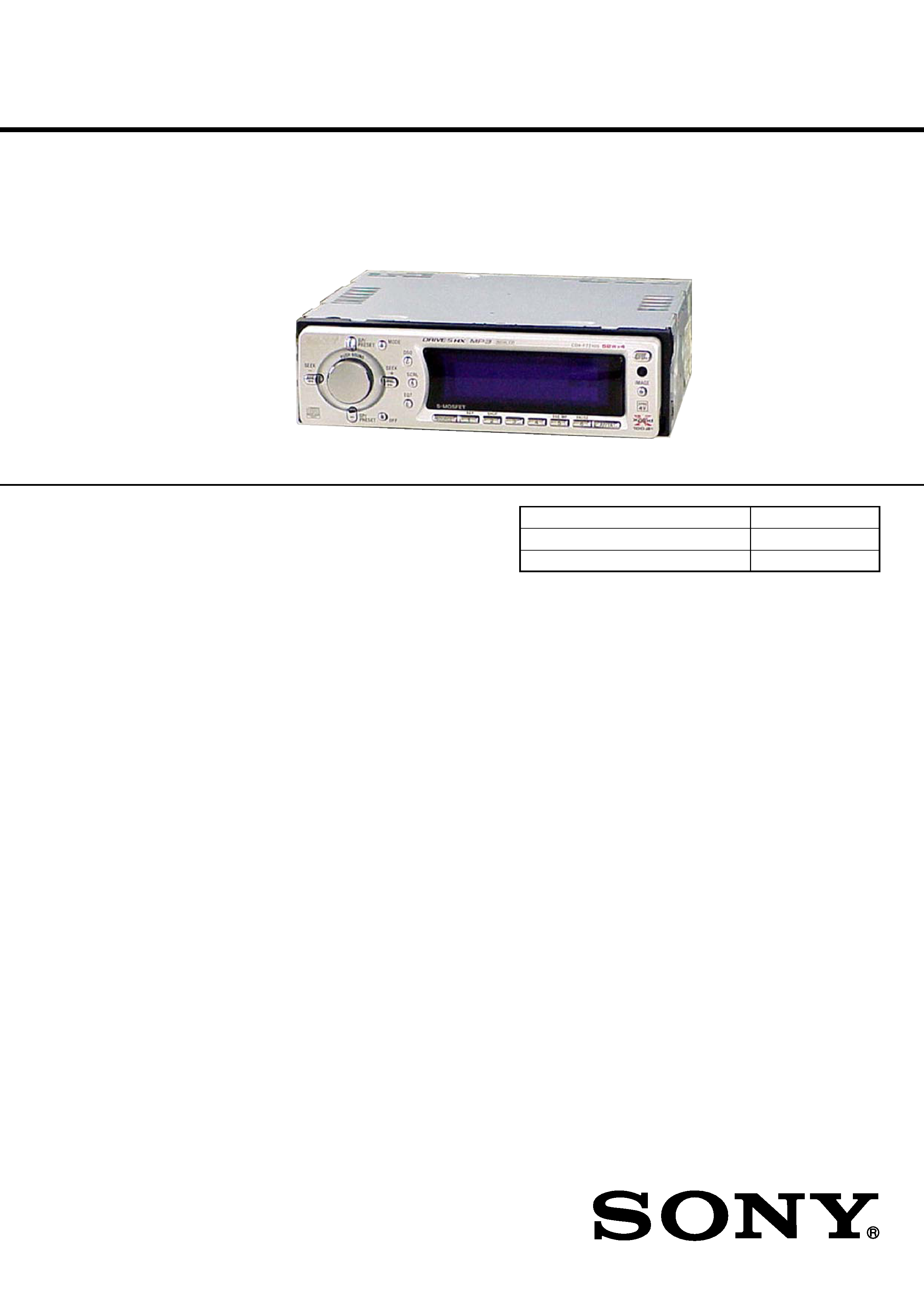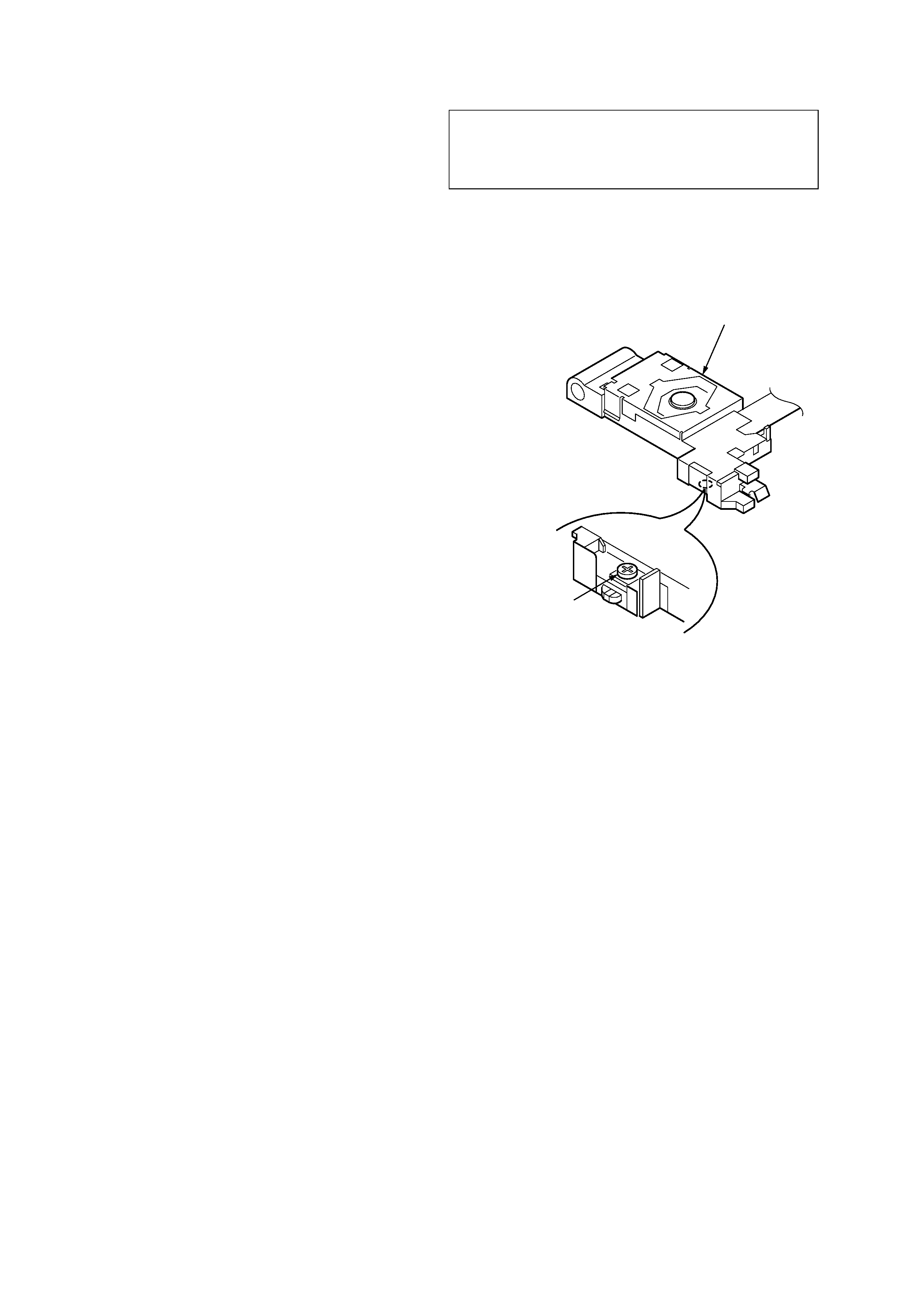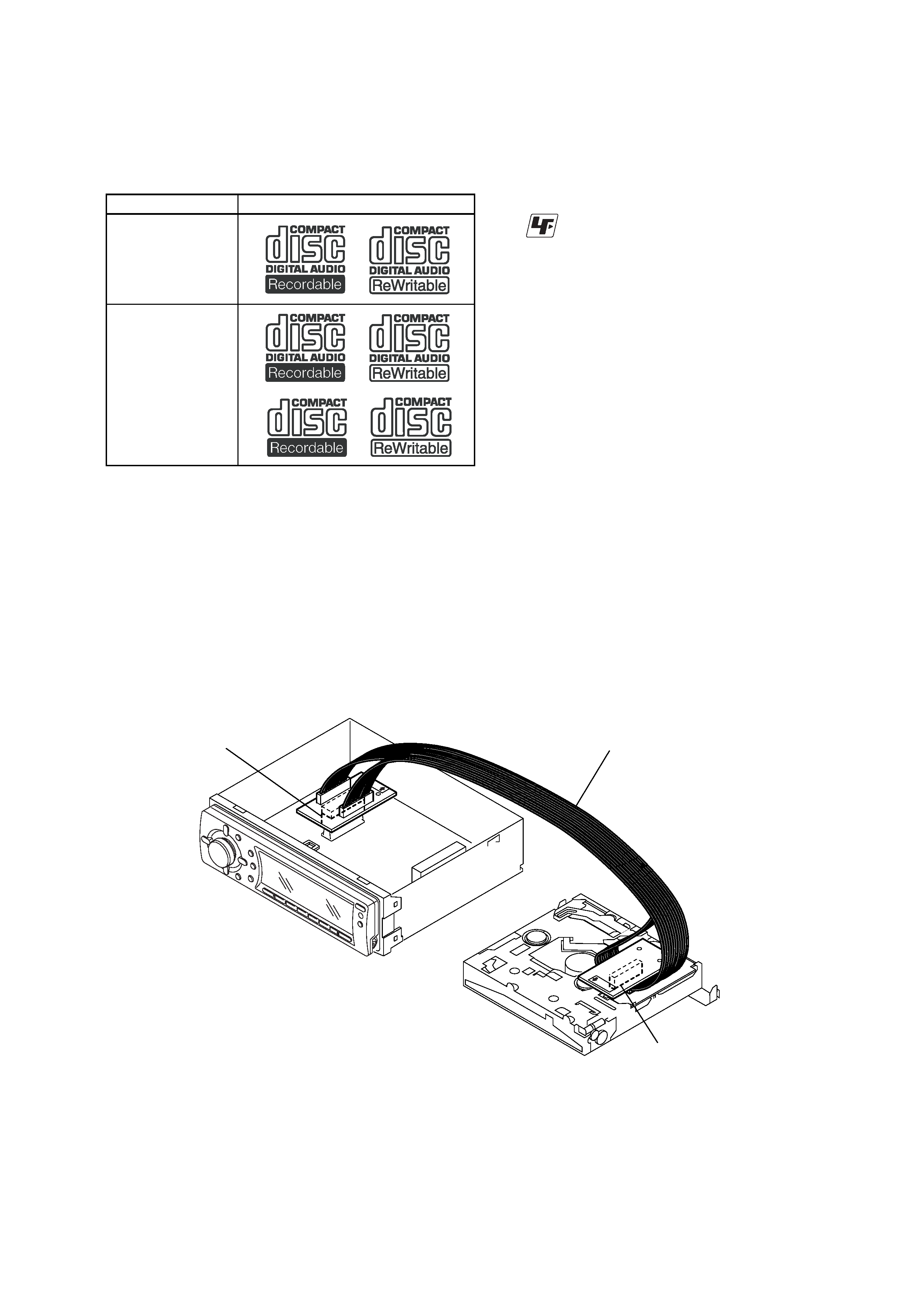
1
Ver. 1.0 2004.12
Model Name Using Similar Mechanism
CDX-F5710/F5710X
CD Drive Mechanism Type
MG-611TA-186//K
Optical Pick-up Name
KSS1000E
SERVICE MANUAL
US Model
Canadian Model
CDX-F7710
AUDIO POWER SPECIFICATIONS (US MODEL)
POWER OUTPUT AND TOTAL HARMONIC DISTORTION
23.2 watts per channel minimum continuous average power into
4 ohms, 4 channels driven from 20 Hz to 20 kHz with no more
than 5% total harmonic distortion.
CD player section
Signal-to-noise ratio
120 dB
Frequency response
10 20,000 Hz
Wow and flutter
Below measurable limit
Tuner section
FM
Tuning range
87.5 107.9 MHz
Antenna terminal
External antenna connector
Intermediate frequency
10.7 MHz/450 kHz
Usable sensitivity
9 dBf
Selectivity
75 dB at 400 kHz
Signal-to-noise ratio
67 dB (stereo),
69 dB (mono)
Harmonic distortion at 1 kHz
0.5% (stereo),
0.3% (mono)
Separation
35 dB at 1 kHz
Frequency response
30 15,000 Hz
AM
Tuning range
530 1,710 kHz
Antenna terminal
External antenna connector
Intermediate frequency
10.7 MHz/450 kHz
Sensitivity
30 µV
SPECIFICATIONS
Power amplifier section
Outputs
Speaker outputs
(sure seal connectors)
Speaker impedance
4 8 ohms
Maximum power output 52 W
× 4 (at 4 ohms)
General
Outputs
Audio outputs terminal (front/rear)
Subwoofer output terminal (mono)
Power antenna relay control terminal
Power amplifier control terminal
Inputs
Telephone ATT control terminal
Illumination control terminal
BUS control input terminal
BUS audio input/AUX IN terminal
Remote controller input terminal
Antenna input terminal
Tone controls
Bass: ±10 dB at 62 Hz
Treble: ±10 dB at 16 kHz
Loudness
+8 dB at 100 Hz
+2 dB at 10 kHz
Power requirements
12 V DC car battery
(negative ground)
· The tuner and CD sections have no adjustments.
Sony Corporation
e Vehicle Company
Published by Sony Engineering Corporation
9-879-360-01
2004L04-1
© 2004. 12
Continued on next page
FM/AM COMPACT DISC PLAYER

2
CDX-F7710
If the optical pick-up block is defective, please replace the whole
optical pick-up block.
Never turn the semi-fixed resistor located at the side of optical
pick-up block.
CAUTION
Use of controls or adjustments or performance of procedures
other than those specified herein may result in hazardous
radiation exposure.
SAFETY-RELATED COMPONENT WARNING!!
COMPONENTS IDENTIFIED BY MARK 0 OR DOTTED LINE
WITH MARK 0 ON THE SCHEMATIC DIAGRAMS AND IN
THE PARTS LIST ARE CRITICAL TO SAFE OPERATION.
REPLACE THESE COMPONENTS WITH SONY PARTS WHOSE
PART NUMBERS APPEAR AS SHOWN IN THIS MANUAL OR
IN SUPPLEMENTS PUBLISHED BY SONY.
ATTENTION AU COMPOSANT AYANT RAPPORT
À LA SÉCURITÉ!!
LES COMPOSANTS IDENTIFIÉS PAR UNE MARQUE 0 SUR LES
DIAGRAMMES SCHÉMATIQUES ET LA LISTE DES PIÈCES
SONT CRITIQUES POUR LA SÉCURITÉ DE FONCTIONNEMENT.
NE REMPLACER CES COMPOSANTS QUE PAR DES PIÈCES
SONY DONT LES NUMÉROS SONT DONNÉS DANS CE MANUEL
OU DANS LES SUPPLÉMENTS PUBLIÉS PAR SONY.
Dimensions
Approx. 178
× 50 × 178 mm
(7 1/8
× 2 × 7 1/8 in.) (w/h/d)
Mounting dimensions
Approx. 182
× 53 × 161 mm
(7 1/4
× 2 1/8 × 6 3/8 in.) (w/h/d)
Mass
Approx. 1.3 kg
(2 lb. 14 oz.)
Supplied accessories
Parts for installation and connections (1 set)
Front panel case (1)
Card remote commander RM-X152
US and foreign patents licensed from Dolby Laboratories.
Note
This unit cannot be connected to a digital preamplifier or an equalizer which is Sony
BUS system compatible.
Design and specifications are subject to change without
notice.
NOTES ON HANDLING THE OPTICAL PICK-UP BLOCK
OR BASE UNIT
The laser diode in the optical pick-up block may suffer electrostatic
breakdown because of the potential difference generated by the
charged electrostatic load, etc. on clothing and the human body.
During repair, pay attention to electrostatic breakdown and also use
the procedure in the printed matter which is included in the repair
parts.
The flexible board is easily damaged and should be handled with
care.
NOTES ON LASER DIODE EMISSION CHECK
The laser beam on this model is concentrated so as to be focused on
the disc reflective surface by the objective lens in the optical pick-
up block. Therefore, when checking the laser diode emission, ob-
serve from more than 30 cm away from the objective lens.
Notes on Chip Component Replacement
·Never reuse a disconnected chip component.
· Notice that the minus side of a tantalum capacitor may be
damaged by heat.
TEST DISCS
This set can playback CD-R and CD-ROM discs. The following
test discs should be used to check the capability:
CD-R test disc TCD-R082LMT (Part No. J-2502-063-1)
CD-RW test disc TCD-W082L (Part No. J-2502-063-2)
SERVICE NOTES
optical pick-up
semi-fixed resistor

3
CDX-F7710
· CD Playback:
You can play CD-DA (also containing CD TEXT*1), CD-R/CD-
RW (MP3 files also containing Multi Session and ATRAC CD
(ATRAC3 and ATRAC3plus format).
Type of discs
Label on the disc
CD-DA
MP3
ATRAC CD
*1 A CD TEXT disc is a CD-DA that includes information such as
disc, artist and track name.
EXTENSION CABLE AND SERVICE POSITION
When repairing or servicing this set, connect the jig (extension cable)
as shown below.
· Connect the MAIN board (CNP301) and the SERVO board (CN2)
with the extension cable (Part No. J-2502-076-1).
z
UNLEADED SOLDER
Boards requiring use of unleaded solder are printed with the lead
free mark (LF) indicating the solder contains no lead.
(Caution: Some printed circuit boards may not come printed with
the lead free mark due to their particular size)
: LEAD FREE MARK
Unleaded solder has the following characteristics.
· Unleaded solder melts at a temperature about 40 °C higher
than ordinary solder.
Ordinary soldering irons can be used but the iron tip has to be
applied to the solder joint for a slightly longer time.
Soldering irons using a temperature regulator should be set to
about 350 °C.
Caution: The printed pattern (copper foil) may peel away if
the heated tip is applied for too long, so be careful!
· Strong viscosity
Unleaded solder is more viscou-s (sticky, less prone to flow)
than ordinary solder so use caution not to let solder bridges
occur such as on IC pins, etc.
· Usable with ordinary solder
It is best to use only unleaded solder but unleaded solder may
also be added to ordinary solder.
SERVO BOARD
CN2
MAIN BOARD
CNP301
J-2502-076-1

4
CDX-F7710
TABLE OF CONTENTS
1. GENERAL
Location of Controls ................................................................ 5
Connections ............................................................................. 5
2. DISASSEMBLY
2-1. Sub Panel Assy (CD) ........................................................... 8
2-2. CD Mechanism Block ......................................................... 8
2-3. Main Board ......................................................................... 9
2-4. Chassis (T) Sub Assy .......................................................... 9
2-5. Roller Arm Assy ................................................................ 10
2-6. Chassis (OP) Assy ............................................................. 10
2-7. Optical Pick-up ................................................................. 11
2-8. SL Motor Assy (M902) ..................................................... 11
2-9. LE Motor Assy (M903) ..................................................... 12
2-10. Servo Board ....................................................................... 12
3. DIAGRAMS
3-1. Block Diagram CD Section ........................................... 13
3-2. Block Diagram Main Section ........................................ 14
3-3. Block Diagram Display Section .................................... 15
3-4. Circuit Boards Location .................................................... 16
3-5. Printed Wiring Boards CD Mechanism Section ............ 17
3-6. Schematic Diagram CD Mechanism Section (1/2) ....... 18
3-7. Schematic Diagram CD Mechanism Section (2/2) ....... 19
3-8. Printed Wiring Boards Main Section ............................ 20
3-9. Schematic Diagram Main Section (1/4) ........................ 22
3-10. Schematic Diagram Main Section (2/4) ........................ 23
3-11. Schematic Diagram Main Section (3/4) ........................ 24
3-12. Schematic Diagram Main Section (4/4) ........................ 25
3-13. Printed Wiring Board Relay Section ............................. 26
3-14. Printed Wiring Board Display Section .......................... 27
3-15. Schematic Diagram Display Section ............................. 28
4. EXPLODED VIEWS
4-1. Main Section ..................................................................... 38
4-2. Front Panel Section ........................................................... 39
4-3. CD Mechanism Section (1) ............................................... 40
4-4. CD Mechanism Section (2) ............................................... 41
4-5. CD Mechanism Section (3) ............................................... 42
4-6. CD Mechanism Section (4) ............................................... 43
5. ELECTRICAL PARTS LIST ........................................ 44

5
CDX-F7710
SECTION 1
GENERAL
This section is extracted
from instruction manual.
· LOCATION OF CONTROL
6
Location of controls and basic operations
Main unit
Front panel removed
Card remote commander
RM-X152
Refer to the pages listed for details. The
corresponding buttons on the card remote
commander control the same functions as those
on the unit.
A SEEK /+ buttons
Radio:
To tune in stations automatically (press); find
a station manually (press and hold).
CD:
To skip tracks (press); skip tracks
continuously (press, then press again within
about 1 second and hold); fast-forward/
reverse a track (press and hold).
B Volume control dial/SOUND button 9
To adjust volume (rotate); select sound items
(press).
C MODE button 8, 12
To select the radio band (FM/AM)/select the
unit*1.
D DSO button 2
To select the DSO mode (1, 2, 3 or OFF).
The larger the number, the more enhanced
the effect.
PUS
H SOUND
GP/
PRESET
MODE
GP/
PRESET
SEEK
+
SEEK
IMAGE
OFF
DSO
EQ7
SCRL
REP
SHUF
BBE MP
PAUSE
6
OPEN
D
E
SOURCE
DSPL
1
S
25
34
CDX-F7715X
CDX-F7710
12 3
4 5
6
7
8
9q; qa
qs
qd
qf
qg
RESET
qh
qj
qk
OFF
DSPL
REP
SHUF
MENU
SCRL
LIST/
CAT
SOURCE
SOUND
MODE
PAUSE
13
2
46
5
ATT
VOL
+
+
ENTER
qs
wg
ql
wf
3
q;
5
w;
wa
qf
wd
ws
qd
wh
7
E SCRL (scroll) button 8
To scroll the display item.
F Display window
G OPEN button 5
H Receptor for the card remote
commander
I GP*2/PRESET +/ buttons
To select preset stations/skip groups (press);
skip groups continuously (press and hold).
J OFF button
To power off/stop the source.
K EQ7 (equalizer) button
To select an equalizer type (Xplod, VOCAL,
CLUB, JAZZ, NEWAGE, ROCK, CUSTOM
or OFF).
L SOURCE button
To power on/change the source (Radio/CD/
MD*3/AUX*4).
M Number buttons
Radio:
To receive stored stations (press); store
stations (press and hold).
CD/MD*3:
(1): REP 8
(2): SHUF 8
(5): BBE MP*5*6 3
To activate the BBE MP function, set "BBE
MP on." To cancel, set "BBE MP off."
(6): PAUSE*6
To pause playback. To cancel, press again.
N DSPL (display) button 8, 10
To change display items.
O IMAGE button 2
To select the display image.
Space Producer mode t Wall paper mode
1-3 t Spectrum analyzer mode 1-5 t
Movie mode 1-3 t normal play/reception
mode
P RESET button 4
Q Z (eject) button 5
To eject the disc.
R Disc slot 5
To insert the disc.
The following buttons on the card remote
commander have also different buttons/functions
from the unit.
ql MENU button
To enter menu.
w; ENTER button
To complete a setting.
wa < (.)/, (>) buttons
To control radio/CD, the same as (SEEK) /
+ on the unit.
ws VOL (volume) +/ button
To adjust volume.
wd ATT (attenuate) button
To attenuate the sound. To cancel, press
again.
wf SOUND button 9
To select sound items.
wg LIST/CAT*7 button 9, 12
To list up.
wh M (+)/m () buttons
To control radio/CD, the same as
(GP/PRESET) +/ on the unit.
*1 When a CD/MD changer is connected.
*2 When an MP3/ATRAC CD is played and a changer
is not connected. If the changer is connected, the
operation is different, see page 12.
*3 When an MD changer is connected.
*4 When an optional Sony portable device is
connected.
*5 The unit only.
*6 When playing back on this unit.
*7 When the XM tuner is connected.
Note
If the unit is turned off and the display disappears, it
cannot be operated with the card remote commander
unless (SOURCE) on the unit is pressed, or a disc is
inserted to activate the unit first.
Tip
For details on how to replace the battery, see
"Replacing the lithium battery of the card remote
commander" on page 14.
· CONNECTIONS
Connection example (2)
Notes (2-A)
·
Be sure to connect the ground lead before connecting the
amplifier.
·
The alarm will only sound if the built-in amplifier is used.
Tip (2-B- )
For connecting two or more CD/MD changers, the source
selector XA-C30 (optional) is necessary.
Ejemplo de conexiones (2)
Notas (2-A)
·
Asegúrese de conectar primero el cable de conexión a masa
antes de realizar la conexión del amplificador.
·
La alarma sonará únicamente si se utiliza el amplificador
incorporado.
Sugerencia (2-B- )
Si desea conectar dos o más cambiadores de CD/MD,
necesitará el selector de fuente XA-C30 (opcional).
Exemple de raccordement (2)
Remarques (2-A)
·
Raccordez d'abord le câble de mise à la masse avant de
raccorder l'amplificateur.
·
L'alarme est émise uniquement lorsque l'amplificateur intégré est
utilisé.
Conseil (2-B- )
Dans le cas du raccordement de deux changeurs de CD/MD ou
plus, le sélecteur de source XA-C30 (en option) est requis.
AUDIO OUT
FRONT
AUDIO OUT
REAR
SUB OUT (MONO)
BUS AUDIO IN
BUS CONTROL IN
A
B
BUS AUDIO IN
BUS CONTROL IN
* not supplied
non fourni
no suministrado
Source selector*
Sélecteur de source*
Selector de fuente*
XA-C30
